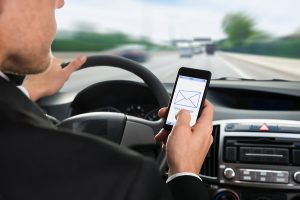Distracted Driving Is More Dangerous Than Drunk Driving
 Michael Babboni
Personal Injury
It’s quite alarming to see that in the last ten years there has been a new heir apparent to the throne of driving while under the influence, and few people in the general public have taken notice. In fact, many have participated in this act, even though these same people have the good conscience to never endanger others on the road by driving while drunk.
Michael Babboni
Personal Injury
It’s quite alarming to see that in the last ten years there has been a new heir apparent to the throne of driving while under the influence, and few people in the general public have taken notice. In fact, many have participated in this act, even though these same people have the good conscience to never endanger others on the road by driving while drunk.The new killer on the road is distracted driving, either by texting, taking selfies, or talking on the phone, and statistics now show it has overtaken DUI-related accidents and deaths as the #1 cause of vehicular mishaps in America today.
Amazingly, however, it does not carry the same public or legal stigma as drunk driving. The same people that would take decisive, proactive action to prevent a loved one from drinking too much and getting behind the wheel are now the same ones that bring out the phone, set the camera to “record” and sing songs to the lens while the driver ignores the road to take part in the action.
The legal regulations for distracted driving vary from state to state. Montana and Arizona are the only two states in the country where texting while driving is still legal. Texas and Missouri have partial bans on texting, while all the remaining states—including Florida—have now declared texting while driving as illegal.
There are some big differences in just how severe the punishments are for breaking this law. Alaska, for example, has the harshest punishment for texting and driving, with a fine of up to $10,000 for people who are caught texting while driving. Florida, which only recently banned texting while driving in 2013, has a $30 fine in comparison, which is not much incentive to stop.
This is why in the event of a traffic accident, one of the first things you should do after assessing the safety of those around you is trying to “preserve the scene.” Everything that happened in the moments leading up to the accident should be preserved. If you were the victim of the accident, with the other driver having collided into you, you might want to make sure that the other driver uses their phone to call for emergency services, or perhaps not at all.
One thing that a person texting or taking selfies with their phone will do if such negligence got them into an accident is realize that their phone can implicate them in court. Because a text message, video, or photograph contains a time-stamp of when that data was created, it can be used as very strong evidence in court to place the blame squarely on their shoulders. Some people, despite being at fault, will attempt to hide this, by deleting the evidence on their phone of wrong doing, perhaps even contacting the person they were texting and advising them to delete the conversation they were having so as to prevent an investigation from finding critical evidence of their negligence.
These are all factors you should consider when you discuss the case with your personal injury lawyer. Even if you can’t prevent the other driver from destroying critical evidence, you should bring these details to the attention of your lawyer. Every bit helps.
